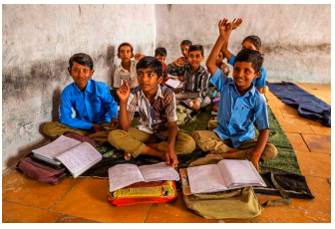
Shaping a National Curriculum Framework using only the National Education Policy will be shortsighted.
The National Council of Educational Research and Training (NCERT) has tasked the State Councils of Educational Research and Training (SCERTs) to develop four State Curriculum Frameworks (SCFs). They pertain to School Education, Early Childhood Care and Education (ECCE), Teacher Education (TE) and Adult Education (AE). This is as in the recommendations of the National Education Policy (NEP) 2020.
At the first level, the NCERT will provide templates to the States to develop four draft SCFs, the drafts will feed into formulating the National Curriculum Frameworks, or NCFs, and the final version of the NCFs will be used as guiding documents to finalise the SCFs. The SCERTs are also supposed to develop 25 position papers, which will be similarly used to develop national position papers. The cycle seems to be designed to take onboard suggestions from all States, thereby making the NCFs representative and inclusive documents. The NCERT will also provide support to the SCERTs in terms of guidance, training of personnel, and technology platforms to develop these documents.
Much data collection
So far so good. But the NCERT will also provide e-templates for each of these tasks “which will be filled-up by the States/UTs [Union Territories]”. Similarly, survey questionnaires/multiple choice questions, or MCQs, will also be provided to conduct surveys among various stakeholders. Thus, massive data collection seems to be in progress. Such surveys are designed, let us accept, with all good intentions to take on board views from all sections of the population. This is without doubt a must in a democracy, particularly in matters of deciding the aims, the objectives, and the content of curriculum because it affects everyone.
However, the gathering and the organisation of such data to be used in curricular decisions requires more than just good intentions. The kind of questionnaires and template that one develops can emphasise certain kinds of recommendations while muting some others. Similarly, the cleaning and organising of the data may pick up what is already in the minds of the people handling such data and filter out what does not fit within their thinking. Even if these two problems are somehow solved, the problem of what the majority ‘wants’ and what ‘ought to be’ done remains. For example, if one asks about public opinion on the medium of instruction for the ECCE, the overwhelming majority is likely to favour English. Does it mean this would be in the best interest of the children and society?
Some valid questions
A huge opinion gathering exercise preceded NEP 2020. One wonders why this could not prevent it from becoming a managerial policy geared to make education a training endeavour to produce a workforce for market needs. The policy is chock-a-block with words for values, capabilities and skills, all justified as needed for emerging market requirements. Furthermore, these lists are just heaps of words, devoid of any organising principle to decide priorities, inter-relationships and deriving curricular content and pedagogy from them. A similar unorganised list is repeated ad nauseum in the name of pedagogical recommendations. And yet, it fails to provide appropriate criteria to choose pedagogy at different stages and for different curricular areas.
The so-called foundational stage crumbles under the slightest scrutiny on organisational as well as pedagogical grounds. The ECCE plus Classes one and two (first five years of education, for the age group three years to eight years) is proclaimed as one stage. But the ECCE and Classes one and two will be run in separate institutions; their teachers’ qualifications, salaries, and training are supposed to be different; their curriculum frameworks are supposed to be different. One wonders what makes it a single block.
On pedagogical grounds, the capabilities of self-restraint, dealing with adults and people outside family, concentration span, responsible behaviour, self-directed activities and understanding the value of completing a task widely differ for a four-year-old and a six-year-old. These are the capabilities which determine the nature of pedagogy and formal learning; not the forming of synapses and the growth of brain mass.
Thus, the people developing NCFs have to deal with these issues in addition to finding a method of making proper sense of gathered public opinion. If the National Curriculum Framework for School Education (NCFSE) is purely guided by the NEP 2020, we are unlikely to ensure the sound development of our schoolchildren. Fortunately, there is a way through which the teams developing the NCF and the SCFs can mitigate — if not completely solve — the problems created by the NEP 2020 as well as take on board public opinion in an appropriate manner. Furthermore, such a framework can also help in making appropriate use of what is good in this policy, for it is not completely devoid of good recommendations. For example, flexibility in secondary education, examination reform, more exposure to Indian languages, and taking on board Indian knowledge systems can make our education system better.
Documents of value
One way out of this problem is to take a lot of help from the Secondary Education Commission Report (SECR) and Zakir Hussain’s Basic National Education (BNE) report. The purpose of surveys on public opinion is to create a consensus on basic values, and the vision and the direction our education system should take. The SERC assumes, without saying, that the democratic polity we adopted gives us that consensus. They also collected a lot of data, but that data was analysed and organised in the light of the vision of the individual, society, and education inherent in the democratic ideal. Thus, they had all the three necessary elements: the overall framework of values and future direction, current issues and problems of the education system, and public opinion. The SECR makes sense of the latter two in the light of the earlier. And it rigorously works out the aims of education, pedagogy and content to achieve those aims. The logical rigor is very clear in working our aims from the democratic values and pedagogy from the aims. It is somewhat loose in working out the content. But the direction is clear.
Another useful document in this regard is the BNE. The logical flow in this document may be somewhat amiss at one or two places in the beginning. But the rigorous derivation of educational aims from the vision of society, curricular objectives from the aims, and content from the objectives are starkly clear. These are coherent and rigorous documents because they place the values and principles of democracy and a morally, aesthetically and intellectually rich individual life at the starting point and try to resolve current economic problems in alignment with them. The current policy reverses the order. It is not that the content from these documents should be borrowed; rather, that the approach they take has much to teach. It is rigorous, rational, and very sound.
Interestingly, the first edition of the BNE was in 1938 (https://bit.ly/2V2I9ij), SECR was written in the 1950s. Patricia White, a British philosopher of education, first argued for making democracy the basis for working out the school curriculum in 1973. John White worked out a rigorous method for the same in a paper published in 1998. The BNE and the SECR do not philosophically argue or give the detailed exposition of the method; they make practical use of this approach. It is somewhat surprising that the reports and curriculum frameworks developed after the 1980s in our country are completely overwhelmed by the current problems or by the pedagogical ideals of child-centrism and simply assumed that vague assumptions about the democratic ideals mentioned here and there randomly was enough. The objectives and content in these later documents are based on other fashionable or political or current issues.
Placing the debate
It is time to again place the democratic ideal at the centre of our education. Not as an object of lip service or reverence, but as the source of a framework of values and principles to judge and justify all other aspects. Otherwise, we are likely to make the curriculum a political football, and stir up debates that border on cacophony. Let us remember that opinions without supporting arguments are nothing more than assertions. And one citizen’s assertions are only as good as another’s. This leaves the conclusion of the debate to the most powerful. The only way to wrest the judgment from the hands of the powerful is to have the curricular debates rooted in democratic values.



